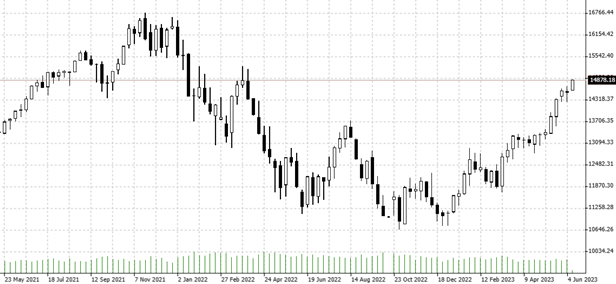

13.06.2023 – The current bull market on the stock exchanges is primarily a product of monetary policy. By keeping interest rates low for a long time and buying up assets – especially government bonds – the central banks have pumped huge amounts of money into the market. Soon we will know whether this will continue: Tomorrow, Wednesday, the Federal Reserve in the U.S. will have its say, on Thursday the European Central Bank (ECB). And on Friday, it will be the turn of the Bank of Japan.
Let’s look at the U.S. first. The stock market expects a pause in interest rate hikes: Analysts at CME Fedwatch last saw the probability of the Fed holding its feet still this time at 70 percent. Because the latest unemployment figures in the U.S. surprised to the upside: Initial claims as of 03 June climbed by 28,000 to the 261,000 and thus to the highest level since October 2021, cooling fears of a new rate hike by the Fed.
The market also expects today’s U.S. inflation figures to ease. The consensus among analysts is that: The Consumer Price Index for May will only rise by 4.1 percent after plus 4.9 percent year-on-year in April. And that, too, should give the Fed fewer arguments for a new rate hike.

Source: Bernstein Bank GmbH
As a result, the S&P 500 is trading at its highest level in more than 13 months, while the Dow Jones Industrial managed to reach a six-week high. And the Nasdaq 100 is holding higher than it has in 14 months, shown here in the weekly chart.
Time lag
The question remains why prices have risen in recent weeks even though interest rates had already been raised sharply. This should have hurt the interest rate-sensitive high-techs in particular. It did – statisticians registered many new entrants in the unemployment figures from industries that rely on fresh loans and now find it difficult to pay for them.
However, the market is being pulled by a few established mega caps with large cash holdings that do not rely on fresh bank loans. Second, prices climbed because the stock market is trading the future and just sees an end to tightening. Further, it takes time for high interest rates to hit the market and sap liquidity. Because low-interest loans and government bonds are only gradually being phased out and replaced by new, more expensive ones. Only when new business comes in do companies, banks and funds have less money available for equities. It is unclear when this effect will take hold in the market.
Liquidity for the stock market
Another exciting question this week will be how asset purchases will continue. The central banks have bought up trillions of euros, dollars, pounds and yen worth of securities, especially government bonds. As of the end of May 2023, according to the OECD, the value of all assets on the ECB’s books was a staggering 56 percent of the eurozone’s gross domestic product. In the U.S., this figure is 32 percent, in the U.K. 40 percent and in Japan as much as 132 percent. The buy-up gave banks and funds liquidity to invest.
The conclusion to be drawn from all this is that if the central banks pause in their tightening and continue to buy up assets, the rally is likely to gather even more momentum. However, if they unexpectedly and sharply raise interest rates and curb the purchase of securities, then it could become uncomfortable for the bulls. Whether long or short – Bernstein Bank wishes successful trades and investments!
________________________________________________________________________________________________________________
The content of this publication is for general information purposes only. In this context, it is neither an individual investment recommendation or advice nor an offer to purchase or sell securities or other financial products. The content in question and all the information contained therein do not in any way replace individual investor- or investment-oriented advice. No reliable forecast or indication for the future is possible with respect to any presentation or information on the present or past performance of the relevant underlying assets. All information and data presented in this publication are based on reliable sources. However, Bernstein Bank does not guarantee that the information and data contained in this publication is up-to-date, correct and complete. Securities traded on the financial markets are subject to price fluctuations. A contract for difference (CFD) is also a financial instrument with leverage effect. Against this backdrop, CFD trading involves a high risk up to the point of total loss and may not be suitable for all investors. Therefore, make sure that you have fully understood all the correlating risks. If necessary, ask for independent advice. CFDs are complex instruments and are associated with the high risk of losing money quickly because of the leverage effect. 68% of retail investor accounts lose money trading CFD with this provider. You should consider whether you understand how CFD work and whether you can afford to take the high risk of losing your money.7
